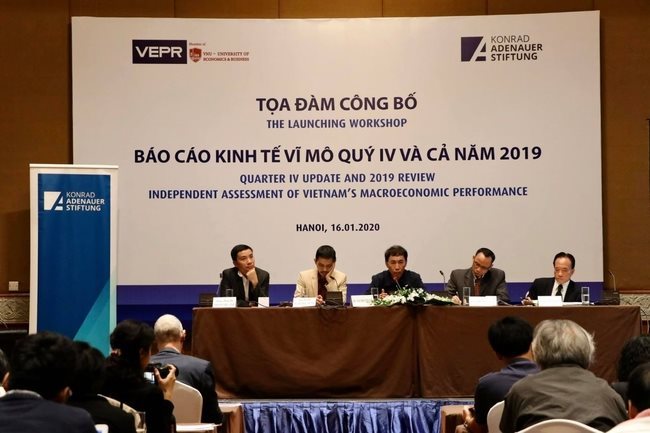 |
| A panel of economists at a workshop, held in Hanoi on January 16 – PHOTO: VEPR |
The VEPR and Germany’s Konrad Adenauer Stiftung held a workshop in Hanoi on January 16 to launch their joint report, called “Fourth Quarter Update and 2019 Review: Independent Assessment of Vietnam’s Macroeconomic Performance,” reported the Vietnam News Agency.
The report said that Vietnam’s economic outlook in the long run will rely on the attraction of foreign direct investment, the removal of institutional barriers, the improvement of the business environment and the equitization of State-owned enterprises.
Vietnam’s economy experienced positive results in 2019, but it will be a challenge to repeat the strong growth this year, said VEPR’s lead economist Pham The Anh.
“Though Vietnam’s economy still grew in the fourth quarter of 2019, despite global economic and political uncertainty, it is at risk of inflation.”
He noted that the inflation average was kept below 4% last year, but the rate in December soared to more than 5%.
“With 7.02% growth in gross domestic product (GDP) last year, Vietnam is still a bright spot of economic development in the region and the world,” he explained, adding that it would not be easy to achieve the country’s planned growth of 6.8% this year.
The industrial and construction sector, the strongest pillar of growth in 2019, was expected to face difficulties due to a subdued real estate market, according to the report.
Meanwhile, the agricultural, forestry and fishery sector grew slowly, due to the severe weather and the African swine fever outbreak.
The service sector, which grew at more than 7% in the finance, banking and insurance, wholesale and retail, transportation and warehouse fields last year, also faced potential risks.
The report predicted the country’s economic growth could reach 6.33% in the first quarter of this year, 6.27% in the second quarter, 6.58% in the third quarter and 6.64% in the last one.
The entire year’s growth is projected at 6.48%. Meanwhile, the inflation rate in the respective quarters would be 4.88%, 4.49%, 4.13% and 4.04%.
“There is not yet a breakthrough in the business investment environment regarding the equitization of State-owned enterprises. Though the Government planned to equitize 128 SOEs by 2020, only 28% of the plan has been realized,” said Vo Tri Thanh, head of the Institute for Brand and Competitiveness Strategy.
Thanh pointed out that the pollution in major cities, especially Hanoi and HCMC, is worsening. “If the situation does not improve, it will badly affect the country’s economic growth.”
International trade and investment activities should improve after the signing of free trade agreements, such as the Comprehensive and Progressive Agreement for Trans-Pacific Partnership and the EU-Vietnam Free Trade Agreement, according to the economist.
“China is the biggest import market of Vietnam, while the United States is the country’s largest export partner. In the midst of the current trade tensions between China and the United States, Vietnam should be very cautious,” he said.
Economist Nguyen Tri Hieu said that Vietnam’s GDP is growing well, but local people’s incomes are very low. Each individual only earns US$2,680 per year on average.
The gross national income per GDP in 2018 was 93%, 5.6 percentage points lower than in 2000, he added. SGT
 Building a transparent legal framework; improving business climate; adopting flexible policies on imports, exports and foreign exchange rates; protecting environment will be needed to achieve economic growth target of 6.8%.
Building a transparent legal framework; improving business climate; adopting flexible policies on imports, exports and foreign exchange rates; protecting environment will be needed to achieve economic growth target of 6.8%.